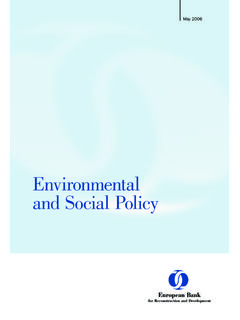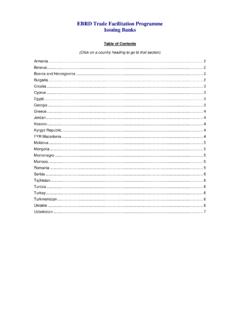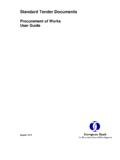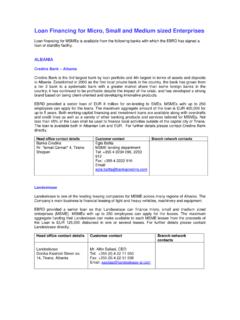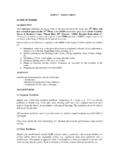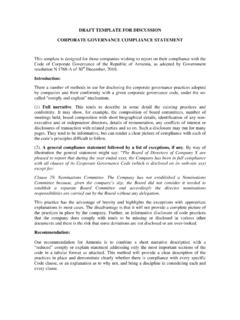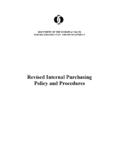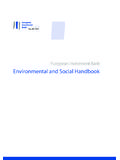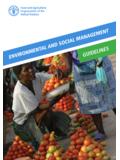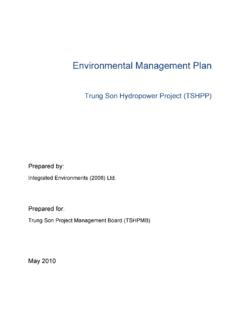Transcription of Environmental and Social Impact Assessment Report
1 Darial Energy LLCD ariali Hydro Power Plant Construction and Operation ProjectEnvironmental and Social Impact Assessment ReportExecutorsScientific Research Firm Gamma"President:V. Gvakharia Stucky Caucasus LLCG eneral Director :B. Quigley2011 SCIENTIFIC RESEARCH FIRM , 0192,Tbilisi, Georgiatel: +(995 32)260 44 33+(995 32) 260 15 C I E N T I F I C R E S E A R C H F I R M G A M M ATable of and Goals of Environmental and Social Impact Assessment legislation and institutional policy and international Framework for Environmental of the key Environmental legislation Impact Assessment Process in and Social Standards of International Policies and Environmental and Social Policy, Financial Corporation Guidelines and of alternatives for the planned Action type HPP construction run-of-the-river HPPs construction Diversion HPP Construction for System Construction and Operation Project Review of the Structure Unit Duct and Service of Construction camp and Construction C I E N T I F I C R E S E A R C H F I R M G A M M Construction Shaft and Power Requirements for Construction Supply and and Domestic Water water and industrial Environmental condition of design work and ethnic and Historical Water and meteorological of and Structural (disjunctive dislocations).
2 Geological Engineering-Geological survey of the headworks and C I E N T I F I C R E S E A R C H F I R M G A M M Location and geotechnical examinations that are requiredto be carried outatthe finaldesign description of Tergi River average annual River maximal River maximal River solid ,typical for the upstream parts of Tergi River of the upstream part of the Tergi and Social Impact and Social Impact Principals of ESIA Receptors and their on Atmospheric Air Assessment Assessment on of Dangerous Geodynamic Processes Assessment C I E N T I F I C R E S E A R C H F I R M G A M M on Surface Assessment on Ground Assessment on Terrestrial and Aquatic Assessment on on Description on Protected Assessment Assessment on Cultural Assessment on Socio-Economic Assessment C I E N T I F I C R E S E A R C H F I R M G A M M of and Use and to Damage, Traffic Load.
3 Limited of Anticipated Measures and Measures and Residual service/ and adjacent and Social Monitoring Plan Preparatory and Construction Plan Operation Emergency and Social Action awareness and participation in the ESIA regarding Comments and Suggestions Received during Public and No1 Waste Storage Conditions and Movement Scheme during Power Plant C I E N T I F I C R E S E A R C H F I R M G A M M OverviewGeorgia is rich in hydropower to the latestdata, technical potential is estimated at93,7billion kWh/y., out of which only 11% isutilized and this cannot ensure afull coverage of thermalenergy demand of the , one of the main directions of the state policy is an optimalutilization of the country's hydropower potential thegovernment intends to utilize existingrenewable energy sources properly(Georgia energy policy and State program Renewable Energy2008 ).
4 A number of small, medium and large-sized hydro power plant construction projects are underconsideration;Several (including cross-border) projects of power generation and transmission areunderway or are under development. Implementation of such projects will contribute to the reductionof electricity imports and will provide an opportunity for Georgia to increase exports to to theeconomic situation of the country, only technically and economically effective hydropowerresources can be utilized. It should also be noted that the land area of Georgia is smalland constructionofHPPs withlarge reservoirs is limited. Construction of Small and medium size run-of-riverhydropower plants is more preferable, because, in this case, the risk of adverse environment effects ismuch less andtheir construction is carried out in a short period of to the preliminary estimation,carried out under consideration ofgeographical location andnatural conditions,construction of the Dariali HPP on Tergi River is considered as one of the mostpromising projects and its implementation willgreatlycontribute to energy independence of of the power plant will be implemented according to the derivative scheme andit will work without a runoff regulation, in a natural flow regime,which, as it was noted, isveryimportant fromanenvironmental point of view.
5 Based on the feasibility study, estimated installedcapacity of HPP is 108MW, which belongs to the category of medium project is fully in line with the European Energy Policy, adopted byEuropean Commission in 2007and with the UN Framework Convention on Climate Change (enacted by Kyoto Protocol in 2005),which calls on all countries to concentrate efforts on increasing the efficiency of energy consumptionthrough increased utilization ofrenewable energy sources and reduction of Environmental aspects of the project are also of the HPP and additional powersupplywill contribute to the region's economic development, employment of the local population andimprovement of their economic implementation will assist the region to maintain existing jobs and businesses (including theservice sector), which will contribute to the improvement of the living conditions of , the local budget will receive taxes paid for water use and property tax as well as taxes paid byservice provides delivering their services to the and Goals of Environmental and Social Impact Assessment ReportThe Environmental and Social Impact Assessment Report is based on Georgian Law on EnvironmentalPermit.
6 According to the article 4, paragraph 1, subparagraph m , location of a Hydro Power Plant(2MW-lessand highercapacity) and Thermal Power Plant (10 MW-and highercapacity)issubject tothe ecological , construction and operation of the HPP in Kazbegi municipality issubject to the ecological expertise and its implementation should be based on ecological C I E N T I F I C R E S E A R C H F I R M G A M M AResolution of ecological expertise is issued by the Ministry of Environmental Protectionon the basis ofecological expertiseofESIA Report for the planned of the given project, along with positive impacts, will have some kind of negativeimpact on the region's natural environment and socio-economic conditions,which may result in loss ofagricultural lands, destruction of biodiversity,damage to cultural heritage,emissions of harmfulsubstances,change of hydrological,geological and hydro geological conditions, etc.
7 The main goalof anESIA is a quantitative Assessment and a spatial scope determination of such negative impacts, including:collection of existing technical documentation of planned activities and information about the naturaland Social environment; determination of the expected Environmental and Social impacts (includingresidual and cumulative)on different phases of the project, on the basis of summing up and analyzingobtained information. The most important part of an ESIA is the identification of mitigation measures,adequate to specific negative impacts; establishment of Environmental management and monitoringschemes,publicawarenessabout the planned activities and their Impact Assessment Report for the construction and operation project of Dariali HPP has been prepared bythe Scientific-Research Firm "Gamma"in compliance with the requirements ofGeorgian Environmental law (GeorgianLaw on"EnvironmentalPermit" and Regulation," Environmental ImpactAssessment" ) andenvironmental and Social policies of EBRD(2008).
8 2 Legal-institutional frameworkThe main goal of the state policy of Georgian in power sector is to fully meet energy demand ofindustrial and domestic sector through sustainable use of the state energy resources, diversification ofsources of imported energy,insuranceof economic independence and energy main directions of the state policy in the energy sectorareapproved bythe resolution of GeorgianParliament on June 7, 2006. The great attention is paid to the local renewable resources, includingutilization ofhydro-resources and alternative energy chapter provides overview of current legislation,standard sand policy in force in Georgia andinternationally, regulatingenvironmental and Social issues and associated with the planned review will be included in theenvironmental and Social Impact Assessment legislation policy objectivesAfter the declaration of independence, Georgia has completely changed its legislation andtoday anewnational legislation is in force, includingtheenvironmental environmentallegislation is mainly based on European legislation andthe principles of sustainable to the formation of a healthy environment and socio-economic development of the country, avariety of programs and plans have been developed and implemented.
9 The most important among themare: Socio-economic recovery and economic growth program, approved in 2001 (PresidentialDecreeN89);EIA-Dariali_HPP9 /205S C I E N T I F I C R E S E A R C H F I R M G A M M A Governmental Program of Georgia "United Georgia Without Poverty"(Parliamentof Georgia, ,resolutionNo 3267); National Environmental Action Plan was adopted in 2000 (Presidential DecreeN191),whichhas beenexpired in2005. At present, adraftdocument is elaborated,which reflects newenvironmental priorities faced by the country; Biodiversity Strategy and Action Plan 20052005(Resolution of the Government of GeorgiaN27).In November 2006, EU-Georgia Action Plan was developed in the framework of "The EuropeanNeighbourhood Policy", which covers a time frame of five years. Since the adoption of the plan, itsimplementation and monitoring is carried outby means of special and international cooperationRegional cooperation by Georgia in Environmental issues covers various fields at differant levels: Georgia is one of the six countries (Armenia, Azerbaijan, Caucasian part of the RussianFederation, North-Eastern Turkey and north-western part of Iran), which represent theCaucasus region and Ecoregion andwhich is historically and geographically considered as theregion between the Black and Caspian Seas; Georgia is included in Black Sea countries and isinvolved in the activities related totheprotection of the Black Sea.
10 In addition, Regional Environmental Centre Caucasus and Caucasus Environmental NGON etwork are functioning in in the Caucasus regionEIA-Dariali_HPP10/205S C I E N T I F I C R E S E A R C H F I R M G A M M agreementsGeorgia is signatory to many international conventions and agreements. Below are given those, whichare important for the Environmental and Social Impact Assessment of HPP construction and operationproject: Protection of natureand biodiversity:oThe Convention on Biological Diversity, Rio de Janeiro, 1992;oThe Convention on Wetlands of International Importance especially as Waterfowl HabitatAreas, Ramsar 1971;oThe Convention on International Trade in Endangered Species of Wild Fauna and Flora(CITES), Washington, 1973;oTheConvention on the Conservation of Migratory Species of Wild Animals, (BonnConvention), 1983. Climate Change:oThe UN Framework Convention on Climate Change, New York, 1994;oThe Montreal Protocol on Substances that Deplete the Ozone Layer, Montreal, signed this protocol in 1996;oThe Vienna Convention for the Protection of the Ozone Layer, 1085;oKyoto Protocol, Kyoto, 1997;oThe United Nations Convention to Combat Desertification, Paris, 1994.
